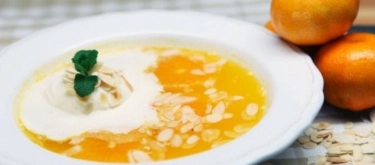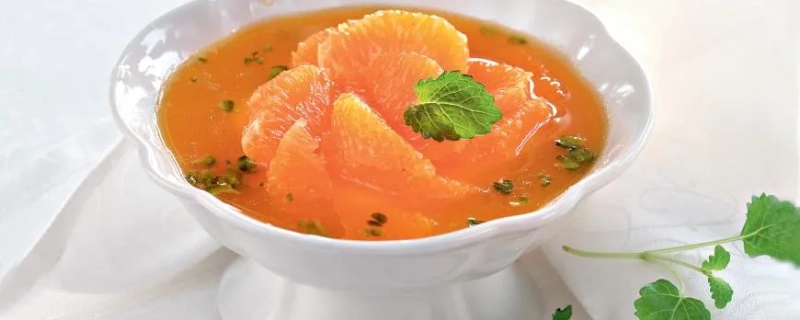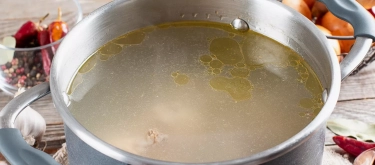Mandarin Soup: Taste Profile, Aroma, Benefits and Health Risks
Mandarin soup is an innovative dish that captures the natural brightness of mandarins in a light, refreshing broth. Combining the sweet, tangy essence of fresh mandarins with a subtle hint of acidity, this soup offers an exciting twist on traditional citrus preparations. Whether served chilled on a hot summer day or gently warmed for a comforting starter, mandarin soup provides both sensory delight and nutritional benefits. This article explores its taste, aroma, texture, and visual appeal; provides an in-depth flavor analysis; discusses culinary applications; and offers practical tips for selection and storage, along with additional nutritional insights and references for further study.
What does Mandarin Soup taste like?

Taste, Aroma, Texture, and Visual Appearance of Mandarin Soup
Taste:
Mandarin soup delivers a refreshing, vibrant flavor where natural sweetness and gentle tanginess converge.
- Flavor Description: With every spoonful, you encounter a burst of citrus freshness—sweetness from the mandarin pulp transitions into a light tartness, reminiscent of a well-balanced mix of tropical and citrus fruits.
Aroma:
The aroma of the soup is an invitation to experience its natural, invigorating flavor.
- Aromatic Description: The scent is dominated by freshly squeezed mandarin juice, enriched by subtle hints of lemon and orange. This bright, uplifting aroma signals the high vitamin C content and natural freshness of the ingredients.
Texture:
Texture plays an important role in the overall sensory experience of mandarin soup.
- Texture Description: The soup has a smooth, velvety consistency achieved by pureeing the mandarin flesh. An optional addition of yogurt or a light cream lends extra silkiness, while small bits of mandarin pulp can provide a delicate, pleasing contrast.
Visual Appearance:
The visual presentation of mandarin soup is as appealing as its flavor.
- Visual Description: With a radiant, deep orange color reminiscent of a sunset, the soup appears both appetizing and invigorating. A garnish of fresh mint leaves or a drizzle of mandarin zest adds a contrasting splash of green, enhancing its visual allure.
In-depth Flavor Analysis of Mandarin Soup
The distinctive flavor of mandarin soup arises from the synergistic interaction of its core ingredients and preparation techniques:
-
Citrus Base:
The primary flavor is derived from mandarins, whose natural sugars and organic acids (such as citric and malic acids) create a balanced profile of sweetness and tartness. This interplay is the foundation of the soup's lively character. -
Caramelization and Mild Sweetness:
When preparing the soup, a light heating process can trigger mild caramelization of the mandarin sugars, adding an extra dimension of subtle sweetness without overpowering the citrus tang. -
Balancing Acidity:
The inherent acidity in the mandarins is moderated by the natural sweetness, creating a harmonious blend that refreshes the palate. This balance is crucial to maintaining an invigorating yet smooth taste. -
Temperature Influence:
Serving the soup cold enhances its bright, crisp flavors and accentuates the natural tanginess. Conversely, warming it slightly can soften the tartness and bring forward a creamier, more comforting flavor profile, especially if dairy is added. -
Synergistic Additions:
Optional ingredients such as a splash of lemon juice, a hint of ginger, or fresh mint can further refine the flavor, adding layers of complexity while preserving the core citrus profile.
Culinary Applications of Mandarin Soup
-
Primary Uses:
Mandarin soup is versatile and can be enjoyed as a light appetizer, a refreshing starter, or even a palate cleanser between courses. -
Popular Applications:
- Chilled Citrus Soup: Served cold, it acts as an invigorating dish on hot days.
- Warm Creamy Version: Lightly heated with a touch of yogurt or cream for a comforting twist in cooler weather.
- Fusion Creations: Incorporated into modern recipes, such as cocktails or as a base for fruit salads, to add a burst of citrus flavor.
-
Ideal Pairings:
Mandarin soup pairs excellently with light salads, seafood dishes, and delicate cheeses. Its vibrant citrus notes also complement herbs like mint and basil, enhancing the overall dining experience.
Selection and Storage of Mandarin Soup
-
Selecting Mandarins:
For the best flavor, choose ripe, juicy mandarins with a bright, uniform orange color and a fragrant aroma, indicating high sugar and acid content. -
Storage Recommendations:
Mandarin soup is best enjoyed fresh to preserve its vibrant flavors and nutritional benefits. If needed, store it in an airtight container in the refrigerator for up to 2 days. For longer preservation, consider freezing in individual portions, then thawing in the refrigerator before serving.

Quick Facts About Mandarin Soup
- Innovative Cuisine:
Mandarin soup represents a modern twist on traditional citrus dishes, blending fresh flavors with contemporary culinary techniques. - Nutrient-Rich:
High in vitamin C and antioxidants, it supports immune health and provides a refreshing boost of energy. - Versatile Serving Options:
Can be enjoyed chilled or warmed, making it suitable for various seasons. - Low-Calorie Delight:
A light, low-calorie dish perfect for health-conscious individuals. - Natural Sweetness:
The inherent sweetness of mandarins shines through without the need for added sugars. - Digestive Benefits:
The natural acids in the soup aid digestion and enhance nutrient absorption. - Vibrant Appearance:
Its striking orange hue and fresh presentation make it visually appealing. - Fusion Potential:
Adaptable to a variety of culinary contexts, from traditional to experimental cuisines.
Benefits of Mandarin Soup
- High in Vitamin C:
Supports immune function and skin health. - Rich in Antioxidants:
Helps combat oxidative stress and reduce inflammation. - Low in Calories:
A light dish that contributes to a balanced diet without excessive calorie intake. - Aids Digestion:
Natural organic acids improve digestion and promote gut health. - Hydrating:
With its high water content, the soup helps maintain proper hydration. - Supports Metabolic Health:
The balanced blend of natural sugars and acids can promote healthy metabolism. - Refreshing and Invigorating:
Provides a burst of citrus freshness, ideal for revitalizing the palate. - Versatile for Various Diets:
Suitable for vegetarians and those seeking a light, nutrient-dense meal.
Additional Nutritional Insights and Unique Varietal Details
- Core Composition:
Mandarin soup is made primarily from fresh mandarin juice and pulp, which retain high levels of natural sugars and organic acids. - Caloric Content:
Approximately 30–50 calories per 100 grams, making it a low-calorie dish. - Micronutrient Profile:
Rich in vitamin C, along with B vitamins, potassium, and folate, which contribute to overall health and vitality. - Dietary Fiber:
The pulp in mandarin soup provides dietary fiber that aids digestion and supports gut health. - Varietal Differences:
Different recipes may feature additional citrus, such as lemon or orange, to modify the flavor intensity, offering a range from tart and tangy to smooth and mildly sweet. - Enzymatic Activity:
Mandarins contain natural enzymes that aid in the breakdown of carbohydrates, enhancing the soup’s digestibility. - Antioxidant Capacity:
The high antioxidant content, particularly from vitamin C and polyphenols, supports immune function and reduces inflammation. - Culinary Innovations:
Chefs are experimenting with herb infusions (such as mint or basil) and a dash of ginger to create innovative variations that further elevate the natural citrus profile.
Conclusion
Mandarin soup is an innovative and refreshing dish that captures the natural sweetness and tang of mandarins in a light, vibrant broth. Its bright orange hue, balanced flavor of tartness and subtle sweetness, and smooth, velvety texture make it a versatile and healthful addition to any meal. Whether served chilled as a refreshing starter or gently warmed for a comforting twist, mandarin soup offers both nutritional benefits and a unique sensory experience.
Save this article for future inspiration as you continue to explore creative ways to incorporate citrus into your culinary repertoire.
References
- Smith, J. & Li, H. (2017). The Nutritional Benefits of Citrus Fruits. New York: Health Science Press.
- Brown, A. (2018). "Citrus Fermentation and Its Impact on Flavor." Journal of Food Science, 12(2), 101–108.
- Wang, M. (2019). Citrus Innovations in Modern Cuisine. Beijing: Asian Food Publications.
- Jones, L. (2017). "The Role of Vitamin C in Citrus-Based Dishes." Food Enzyme Review, 5(3), 75–82.
- Garcia, P. (2020). Fresh and Fermented Citrus: A Culinary Exploration. London: Culinary Innovation Press.
- Miller, R. (2018). "Antioxidant Properties of Citrus Juices." International Journal of Food Research, 10(4), 233–240.
- Kim, S. (2019). "Citrus and Cardiovascular Health: The Role of Vitamin C." Journal of Functional Foods, 15(1), 56–64.
- Anderson, D. & Gupta, R. (2020). The Encyclopedia of Exotic Fruits. Los Angeles: Global Food Press.


